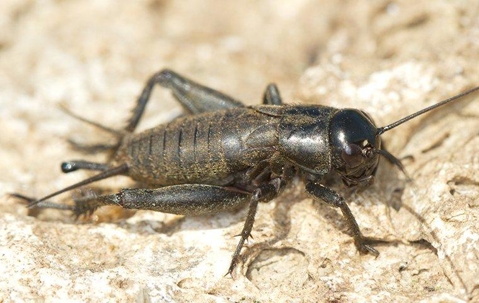Chances are good you’ve seen field crickets and refer to them simply as crickets. They are black in color, with some leaning toward a lighter brown. The adult field cricket can grow between 1/2 and 1 1/8 of an inch in length. Field crickets have wings that lay flat against on their backs. The adult male rubs its hind legs against the wings to make the chirping sounds we are all familiar with. Field crickets also have antennae that are thin and longer than their bodies. These insects have long legs and have heavy bodies that allow them to jump as much as three feet. The nymphs look much the same as adults, just smaller in size.
A Field Cricket's Natural Habitat
Field crickets typically live outside and prefer dark, moist environments. Some of the places you may find field crickets in Streator include in piles of leaves, in drainage ditches, around gardens, near the foundation of your home, or under rocks.
Field crickets are considered agricultural pests. They eat vegetation, plants, and crops like wheat and oats. They can cause significant damage to large crops and even worse damage to smaller gardens and even greenhouses. Although field crickets are typically outdoors, they will get inside your home. Field crickets can get inside your home any time of year, but they are most likely to move into your home in the fall when their food supplies dwindle and they are in search of warmth. They are attracted to moist, damp environments such as basements and cellars. Though their chirping is an annoyance, they don't survive long indoors and will usually be gone by winter.
Problems With Field Crickets In Streator
Crickets appear to be harmless, but once inside your home, they will feed on fabrics and can cause damage to furniture, clothing, and other materials. Field crickets can bite as well, though they are unlikely to penetrate the skin. Field crickets do, however, carry diseases and bacteria such as E. coli and salmonellosis. While these diseases are typically not life-threatening to humans, they can cause sickness and sores. Field crickets can transmit diseases through a bite or through their feces.
How Do I Know If I Have Field Crickets In My Streator Home?
The most obvious sign you have field crickets in your Streator home is the sound of the chirping. They rarely cause damage in the home unless there is a heavy population present. A few crickets aren’t a big deal. If there is a heavy population in your home, however, you may begin to see the telltale signs of damage to furniture and fabrics.
Field Cricket Prevention Tips For Your Streator Home
Like many pests, field crickets enter the home through openings. Like most pests, they will find their way inside through small entry points that are difficult to detect. Therefore, it's important to inspect your home to minimize the risk of developing a field cricket problem. Here are a few tips to prevent field crickets from getting inside:
Caulk around the foundation of the home.
Patch openings and gaps around doors and windows.
Clean around the outside of the home and keep it mowed.
Avoid storing firewood and organic material near the home.
Use yellow sodium lighting instead of mercury vapor.
Position lights away from your doors to attract field crickets away from the home.
Avoid clutter and piles of fabric and organic material. These serve as ideal hiding places for crickets.
Contact The Pest Control Experts At Quik-Kill Pest Eliminators In Streator
If you find you have a problem with field crickets in and around your Streator home, don’t hesitate to contact Quik-Kill Pest Eliminators. Our pest experts will be happy to answer your questions or help you get rid of your field cricket problem. Reach out to us to speak with our pest control experts today.

